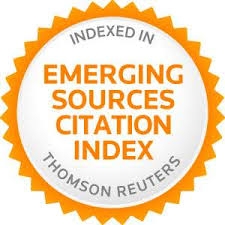Motivos de uso de las redes sociales virtuales: Análisis de perfiles de mujeres rurales
Resumen
Palabras clave
Referencias
Area, M. & Pessoa, T. (2012). De lo sólido a lo líquido: Las nuevas alfabetizaciones ante los cambios culturales de la Web 2.0. Comunicar, XIX, 38, 13-20. http://dx.doi.org/10.3916/C38-2011-02-01
Arteaga, R., Cortijo, V. & Javed, U. (2014). Students' perceptions of Facebook for academic purposes. Computers & Education, 70, 138–149. http://dx.doi.org/10.1016/j.compedu.2013.08.012
Attwell, G. (2007). Personal Learning Environments. The future of e-learning? eLearning Papers, 2(1) Recuperado de http://www.elearningeuropa.info/files/media/media11561.pdf
Brandtzæga P.B., Heim, J. & Karahasanovic, A. (2011). Understanding the new digital divide. A typology of Internet users in Europe. International Journal of Human Computer Studies, 69(3), 123-138. http://dx.doi.org/10.1016/j.ijhcs.2010.11.004
Braun, M. T. (2013). Obstacles to social networking website use among older adults. Computers in Human Behavior, 29, 673–680. http://dx.doi.org/10.1016/j.chb.2012.12.004
Carpenter, J. M., Green, M. C. & LaFlam, J. (2011). People or profiles: Individual differences in online social networking use. Personality and Individual Differences, 50(5), 538-541. http://dx.doi.org/10.1016/j.paid.2010.11.006
Casta-o, C. (2009). La segunda brecha digital y las mujeres jóvenes. Quaderns de la Mediterrània, 11, 218-224. Recuperado de http://www.iemed.org/publicacions/quaderns/11/41_la_segunda_brecha_digital.pdf
Chen, L.Y, Hsiao, B., Chern, C.C. & Chen, H.G. (2014). Affective mechanisms linking Internet use to learning performance in high school students: A moderated mediation study. Computers in Human Behavior, 35, 431–443. http://dx.doi.org/10.1016/j.chb.2014.03.025
Cheung, C. M. K., Chiu, P.Y. & Lee, M. K. O. (2011). Online social networks: Why do students use facebook? Computers in Human Behavior, 27(4), 1337-1343. http://dx.doi.org/10.1016/j.chb.2010.07.028
Clipson, T., Wilson, S. A. & DuFrene, D. D. (2010). The social networking arena: battle of the sexes. Business Communication Quarterly, 75 (1), 1-5.
Coiro, J., Knobel, M., Lankshear, C., & Leu, D. J. (Eds). (2008). Handbook of research in new literacies. Mahwah, NJ: Lawrence Erlbaum Associates.
Correa, T. (2010). The Participation Divide Among ''Online Experts'': Experience, Skills and Psychological Factors as Predictors of College Students' Web Content Creation. Journal of Computer-Mediated Communication, 16, 71–92. http://dx.doi.org/10.1111/j.1083-6101.2010.01532.x
Dabbagh, N., & Kitsantas, A. (2012). Personal Learning Environments, social media, and self-regulated learning: A natural formula for connecting formal and informal learning. The Internet and Higher Education, 15(1), 3-8. http://dx.doi.org/10.1016/j.iheduc.2011.06.002
Dias, I. (2012). O uso das tecnologías digitais entre os seniores. Motivações e intereses. Sociologia, Problemas e Práticas, 68, 51-77. http://dx.doi.org/10.7458/SPP201268693
DiMaggio, P., Hargittai, E., Celeste, C., & Shafer, S. (2004). Digital Inequality: From Unequal Access to Differentiated Use. In K. Neckerman (Ed.), Social Inequality (355-400). New York: Russell Sage Foundation.
Dogruer, N., Menevis, I. & Eyyam, R. (2011). What is the motivation for using Facebook?. Procedia Social and Behavioral Sciences, 15, 2642–2646. http://dx.doi.org/10.1016/j.sbspro.2011.04.162
Ellison, N. B., Steinfield, C. & Lampe, C. (2007). The benefits of Facebook ''friends:" Social capital and college students' use of online social network sites. Journal of Computer-Mediated Communication, 12(4), 1143–1168.
http://dx.doi.org/10.1111/j.1083-6101.2007.00367.x
Falk, I. & Kilpatrick, S. (2000). What is social capital? A study of interaction in a rural community. Sociologia Ruralis, 40 (1), 87-110.
http://dx.doi.org/10.1111/1467-9523.00133
Freese, J., Rivas, S. & Hargittai, E. (2006). Cognitive ability and Internet use among older adults. Poetics, 34, 236-249. http://dx.doi.org/10.1016/j.poetic.2006.05.008
García, A., López-de-Ayala, M.C. & Catalina, B. (2013). Hábitos de uso en Internet y en las redes sociales de los adolescentes españoles. Comunicar, XXI (41), 195-204.
Gómez, M., Roses, S. & Farias, P. (2012). El uso académico de las redes sociales en universitarios. Comunicar, XIX(38), 131-138. http://dx.doi.org/10.3916/C38-2011-03-04
Godfrey, M. & Johnson, O. (2009). Digital circles of support: Meeting the information needs of older people. Computers in Human Behavior, 25, 633–642.
http://dx.doi.org/10.1016/j.chb.2008.08.016
Greenhow, C. & Burton, L. (2011). Help from my "Friends:" Social capital in the social network sites of low-income high school students. Journal of Educational Computing Research, 45(2), 223-245.
http://dx.doi.org/10.2190/EC.45.2.f
Greenhow, C. & Robelia, E. (2009). Informal learning and identity formation in online social networks. Learning, Media and Technology, 34(2), 119-140.
http://dx.doi.org/10.1080/17439880902923580
Hargittai, E. & Hinnant, A. (2008). Digital Inequality: Differences in Young Adults' Use of the Internet. Communication Research, 35(5), 602-621. http://dx.doi.org/10.1177/0093650208321782
Hargittai, E. & Hsieh, Y.P. (2010).Predictors and consequences of differentiated practices on social network sites.Information, Communication & Society, 13(4), 515-536. http://dx.doi.org/10.1080/13691181003639866
Hargittai, E. & Walejko, G. (2008). The participation divide: Content creation and sharing in the digital age. Information, Communication & Society, 11 (2), 239-256. http://dx.doi.org/10.1080/13691180801946150
Hargittai, E. (2002). Second-level digital divide: differences in people's online skills. First Monday, 7 (4), 1-15 http://dx.doi.org/10.5210/fm.v7i4.942
Hargittai, E. (2008). Whose Space? Differences Among Users and Non-Users of Social Network Sites. Journal of Computer-Mediated Communication, 13, 276–297. http://dx.doi.org/10.1111/j.1083-6101.2007.00396.x
Hargittai, E. (2010). Digital Natives? Variation in Internet Skills and Uses among Members of the ''Net Generation''. Sociological Inquiry, 80 (1), 92–113. http://dx.doi.org/10.1111/j.1475-682X.2009.00317.x
Hew, K.F. & Cheung, W.S. (2012). Students' use of asynchronous voice discussion in a blended-learning environment: A study of two undergraduate classes. The Electronic Journal of e-Learning, 10(4) 360-367.
Hsieh, Y.P. (2012). Online social networking skills: The social affordances approach to digital inequality. First Monday, 17 (4), 1-12.http://dx.doi.org/10.5210/fm.v17i4.3893
Imhof, M., Vollmeyer, R. & Beierlein, C. (2007). Computer use and the gender gap: The issue of access, use, motivation, and performance. Computers in Human Behavior, 23(6), 2823-2837.http://dx.doi.org/10.1016/j.chb.2006.05.007
Jackson, L. A., Ervin, K. S., Gardner, P. D., & Schmitt, N. (2001). Gender and the Internet: Women communicating and men searching. Sex Roles, 44(5/6), 363-379. http://dx.doi.org/10.1023/A:1010937901821
Joinson, N. A. (2008). Looking at', 'Looking up' or 'Keeping up with' People? Motives and uses of Facebook. CHI 2008 Proceedings: 1027-1036.
Kwon, M.W. D'Angelo & McLeod, J. D.M. (2013). Facebook use and social capital: To bond, to bridge, or to escape. Bulletin of Science, Technology & Society, 33(5-6). http://dx.doi.org/10.1177/0270467613496767
LaRose, R., Greggb, J.L., Stroverc, S., Straubhaarc, J. & Carpenterd, S. (2007) Closing the rural broadband gap: Promoting adoption of the Internet in rural America. Telecommunications Policy, 31, 359–373. DOI: 10.1016/j.telpol.-2007.04.004
Ley 45/2007, de 13 de diciembre, para el desarrollo sostenible del medio rural. Boletín Oficial del Estado, 299, de 15 de diciembre de 2007.
Lin, C., Tang, W. & Kuo, F. (2012). Mommy Wants to Learn the Computer: How Middle-Aged and Elderly Women in Taiwan Learn ICT Through Social Support. Adult Education Quarterly, 62 (1), 73-90. http://dx.doi.org/10.1177/0741713610392760
Lin, K.Y. & Lu, H.P. (2011). Why people use social networking sites: An empirical study integrating network externalities and motivation theory. Computers in Human Behavior, 27(3), 1152-1161.http://dx.doi.org/10.1016/j.chb.2010.12.009
Livingstone, S. & Helsper, E. (2007). Gradations in digital inclusion: children, young people and the digital divide. New Media & Society, 9(4), 671- 696. http://dx.doi.org/10.1177/1461444807080335
Livingstone, S. & Helsper, E. (2010).Balancing opportunities and risks in teenagers' use of the internet: the role of online skills and internet self-efficacy. .New media & society, 12 (2), 309-329. http://dx.doi.org/10.1177/1461444809342697
Livingstone, S., Van Couvering, E. & Thumim, N. (2008). Converging traditions of research on media and information literacies: disciplinary, critical, and methodological issues. En J. Coiro, M., Knobel, C. Lankshear & D. J. Leu, (Eds.) Handbook of research on new literacies. Mahwah, NJ: Lawrence Erlbaum Associates.
Martinez-Pecino, R., Delerue, A. & Silva, P. (2013.). Portuguese older people and the Internet: Interaction, uses, motivations, and obstacles. Communications - The European Journal of Communication Research, 38(4), 331-346. DOI: 10.1515/commun-2013-0020
Mazman S.G. & Usluel, Y. K. (2011). Gender differences in using social networks. TOJET: The Turkish Online Journal of Educational Technology, 10 (2), 133-139. Recuperado de http://goo.gl/8o42eT
Meyers, E.M., Erickson, I. & Small, R.V. (2013). Digital literacy and informal learning environments: an introduction, Learning, Media and Technology, 38(4), 355-367, http://dx.doi.org/10.1080/17439884.2013.783597
Nadkarni, A. & Hofmann, S. (2011). Why do people use Facebook? Personality and Individual Differences, 52, 243–249. http://dx.doi.org/10.1016/j.paid.2011.11.007
Notley, T. (2009). Young People, Online Networks, and Social Inclusion. Journal of Computer-Mediated Communication, 14, 1208–1227. http://dx.doi.org/10.1111/j.1083-6101.2009.01487.x
Notley, T.M. & Foth, M. (2008). Extending Australia's digital divide policy: an examination of the value of social inclusion and social capital policy frameworks. Australian Social Policy, 7, 1-24.
Novo-Corti, I., Varela-Candamio, L. & García-Álvarez, T. (2014). Breaking the walls of social exclusion of women rural by means of ICTs: The case of "digital divides" in Galician. Computers in Human Behavior, 30, 497–507. http://dx.doi.org/10.1016/j.chb.2013.06.017
Papacharissi, Z. & Mendelson, A. (2011). Toward a new(er) sociability: uses, gratifications and social capital on Facebook. En S. Papathanassopoulos (Ed.), Media Perspectives for the 21st Century. New York: Routledge (pp. 212-230).
Pfeil, U., Arjan, R. & Zaphiris, P. (2009). Age differences in online social networking. A study of user profiles and the social capital divide among teenagers and older users in MySpace. Computers in Human Behavior, 25(3), 643-654. http://dx.doi.org/10.1016/j.chb.2008.08.015
Rebollo-Catalán, A. & Vico, A. (2014). El apoyo social percibido como factor de la inclusión digital de las mujeres de entorno rural en las redes sociales virtuales. Comunicar, 43, 173-180. http://dx.doi.org/10.3916/C43-2014-17
Rubio, M. J. y Escofet, A. (2013). Estudio sobre los usos de las TIC y el empoderamiento de las mujeres. Revista Iberoamericana de Educación, 62(3), 1-13.
Seidman, G. (2013). Self-presentation and belonging on Facebook: How personality influences social media use and motivations. Personality and Individual Differences, 54, 402–407. http://dx.doi.org/10.1016/j.paid.2012.10.009
Selwyn, N. & Facer, K. (2007). Beyond the digital divide: Rethinking digital inclusion for the 21st century. Futurelab: Bristol.
Sloep, P. & Berlanga, A. (2011). Redes de aprendizaje, aprendizaje en red. Comunicar, XIX(37), 55-64. http://dx.doi.org/10.3916/C37-2011-02-05
Smoke, A.D., Ellison, N.B., Lampe, C. & Wohn, D.Y. (2011). Facebook as a toolkit: A uses and gratification approach to unbundling feature use. Computers in Human Behavior, 27, 2322–2329. http://dx.doi.org/10.1016/j.chb.2011.07.011
Staksrud, E., Ólafsson, K. & Livingstone, S. (2013). Does the use of social networking sites increase children's risk of harm? Computers in Human Behavior, 29, 40–50. http://dx.doi.org/10.1016/j.chb.2012.05.026
Steinfield, C., Ellison, N. B. & Lampe, C. (2008). Social capital, self-esteem, and use of online social network sites: A longitudinal analysis. Journal of Applied Developmental Psychology, 29(6), 434-445. http://dx.doi.org/10.1016/j.appdev.2008.07.002
Subrahmanyam, K., Reich, S.M., Waechter, N., Espinoza, G. (2008). Online and offline social networks: Use of social networking sites by emerging adults. Journal of Applied Developmental Psychology, 29, 420-433. http://dx.doi.org/10.1016/j.appdev.2008.07.003
Tosun, L.P. (2012). Motives for Facebook use and expressing ''true self'' on the Internet. Computers in Human Behavior, 28, 1510–1517. http://dx.doi.org/10.1016/j.chb.2012.03.018
Valenzuela, S., Park, N. & Kee, K. (2009). Is there social capital in a social network site?: Facebook use and college students' life satisfaction, trust, and participation. Journal of Computer-Mediated Communication, 14, 875–901. http://dx.doi.org/10.1111/j.1083-6101.2009.01474.x
vanDeursen, A.J. & van Dijk, J.A. (2013). The digital divide shifts to differences in usage. New media & society, 0(0) 1–20. http://dx.doi.org/10.1177/1461444813487959
vanDijk, J.A. (2006). Digital divide research, achievements and shortcomings. Poetics, 34, 221–235. http://dx.doi.org/10.1016/j.poetic.2006.05.004
vanDijk, J.A. (2005). The deepening divide: Inequality in the information society. Thousand Oaks: Sage Publications.
Verges, N. (2012). De la exclusión a la autoinclusión de las mujeres en las TIC. Motivaciones, posibilitadores y mecanismos de autoinclusión. Athenea Digital, 12 (3), 129-150.
Vergés, N., Hache, A. & Cruells, E. (2011). Indagando en la relevancia de internet en el acceso, uso y deseos de las TIC por parte de las mujeres en las TIC. TESI, 12 (2), 105-121.
Yang, C.C & Brown, B. (2013). Motives for using facebook, patterns of Facebook activities, and late adolescents. Social adjustment to college. Youth Adolescence, 42, 403–416. http://dx.doi.org/10.1007/s10964-012-9836-x
Zillien, N & Hargittai, E. (2009). Digital distinction: status-specific Internet uses. Social ScienceQuarterly, 90(2), 274–291.http://dx.doi.org/10.1111/j.1540-6237.2009.00617.x
Enlaces refback
- No hay ningún enlace refback.


